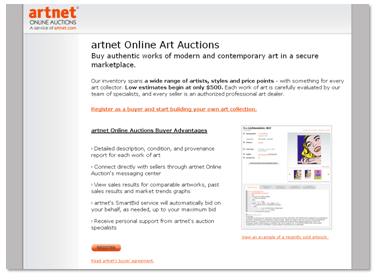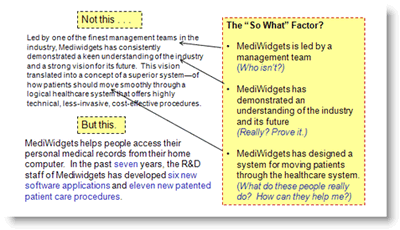One concept that gets continually emphasized in our webinars is the importance of supporting your offer with specific, quantifiable information. Yet, which information and in what order?
Because marketers are intimately familiar with their products or services, generic descriptions of products or services seem perfectly clear. Or, certain characteristics of the company, product or service that are most valuable to customers are overlooked.
For example, in our recent B2C live optimization clinic, the MarketingExperiments team reviewed Artnet.com, an online art auction site.
For the clinic, the site submitted this landing page:

Our Director of Optimization Research Jimmy Ellis’ primary recommendation was, “Test specifics in your ad copy and on your landing page. Work with quantifiable numbers. How many pieces of art have you sold to satisfied customers? What kind of art do you specialize in? How many auctions do you run in a given period of time?”
Great advice, however…
If the site can accurately answer all those questions, how should all that information be organized so that it’s relevant to prospects and not a blur of facts and numbers?
The math behind the face mask
I was recently impressed enough with an Oil of Olay television commercial that I spent $30 on face cream. That’s more money than I’ve spent on my beauty regimen in the last ten years.
It wasn’t the miraculous sculpting-lifting-firming-warding-off-vampires quality of the cream that sold me. It was the strategic presentation of the benefits of their product.
The genius of the Oil of Olay Regenerist commercial was in the layered, purposeful presentation of their facts.
The voiceover begins, “We were surprised when we beat out the $100 cream.” From there, the announcer (female) continues, “And shocked when we were preferred over the $700 one.” And then, after a few shots of glowing complexions, the spot ends with: “Oil of Olay Regenerist: preferred over 32 of the most expensive brands.”
While I’m sure brand recognition and high production values had something to do with its success, the commercial worked, in part, because it focused on a single category of specifics: the specifics of price comparison. In addition, it built its facts in a credible manner. Reverse the order of the information — 32, $700, $100 — and it becomes less believable and less inspiring.
Making the most of your numbers: 3 strategies
Supporting your offer with specific, quantifiable information is both a necessity and an art. When adding such information to your emails or landing pages, consider the following factors:
1. Grow your numbers: There’s a reason “The Twelve Days of Christmas” doesn’t start with a dozen drummers. Instead, it works up from a single partridge (more easily gift wrapped if you tuck the head under the wing) so that by the time you get to the really extravagant stuff, it seems natural.
2. Label with numbers: Oil of Olay didn’t mention any of the virtues of its cream other than that it beat out more expensive creams. But those facts implied other positive qualities.
A friend once told me she had a lot of flip flops.
A lot of flip flops turned out to be fifty-seven pairs.
The oddest thing about her disclosure? Once she told people how many she had, people gave her more pairs of flip flops.
The marketing lesson here? Attribute a specific number of virtues or benefits to your product or company and people may give you credit for more.
3. Strength in numbers: Gather your numbers together, but in moderation. Sprinkling specifics about all the different quantitative aspects of your company all over a landing page will only muddle the eyepath, distract and confuse. But a few, significant numbers, strategically placed, will help prospects see your offer as tangible and desirable.
An example from Dr. Flint McGlaughlin’s paper, “Transparent Marketing,” details how to keep asking “So what?” to transform your offer from general and unremarkable to unique and intriguing. In the paper, he used this approach to revise the value proposition for a hypothetical company called Mediwidgets.
Replacing vague modifiers with specific, quantitative facts, supported by concrete numbers, makes the value proposition shorter, easier to grasp, and more attractive to potential customers.
Paint by numbers
One of the new offerings on Artnet’s site demonstrates how a few, well-chosen numbers can illustrate the numerous benefits the site has for art lovers and collectors:
“artnet’s new Design Marketplace features 20th-21st century furniture and decorative arts for sale from 150 of the world’s top galleries in 75 international cities.”
Sometimes a picture paints 1,000 words and, sometimes, with strategically applied specifics, using the right words paints 1,000 pictures.




Hey there just wanted to give you a quick heads up.
The text in your article seem to be running off the screen in
Internet explorer. I’m not sure if this is a formatting issue or something to do with web browser compatibility but I figured I’d post to let you know.
The design and style look great though! Hope you get the issue resolved soon.
Thanks
Hi Carmine,
Thank you for letting us know. We’ll check it out.
-best,
John Tackett